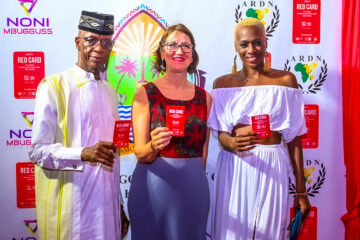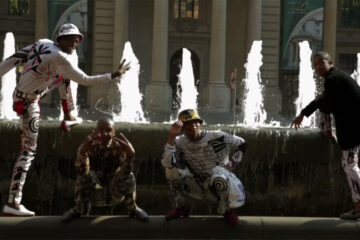THIN LEI WIN and NELLIE PEYTON
BRITISH-BORN Ghanaian designer Samata Pattinson taught herself to sew, launched her own label before the age of 30 and now runs an initiative showcasing sustainable fashion on the Oscars red carpet.
She has found success in a cut-throat industry, but has never been allowed to forget her differences as a Black woman surrounded by mostly white executives, designers and models.
“You feel like you’re in the room, and then there’s another VIP room and you can’t get into that one,” Pattinson told the Thomson Reuters Foundation in a phone interview.
“There’s pressure because you’re acutely aware that there are very few others like you in certain spaces,” she said, recalling when a London-based magazine editor told her she was “perfect” for an opportunity by phone and then went quiet after she sent a picture of herself.
A lack of diversity has long blighted the multi-trillion dollar fashion industry but global protests over the May 25 police killing of an unarmed Black man in the United States has put pressure on those with influence in the profession to stamp out racism and exclusion.
Major fashion houses from Gucci to Prada have pledged to do better, fashion bible Vogue has apologised for mistakes and new initiatives such as the Black in Fashion Council have sprung up to advocate for Black people in the business.
Some fear the recent spike in attention could be fleeting but Black fashion designers like Pattinson say they are already redefining the industry regardless of whether the old establishment is ready for it.
“This collective attitude that we have, as Black designers, Black creatives, people of colour – it’s changed,” said Pattinson.
Rather than holding up London or New York fashion week as the pinnacle of success, they are celebrating the shows in African cities like Lagos and Accra, she said.
“We’re not waiting to be invited to the table. We’re sitting at the table. It’s like this whole redefining of what success is which is, I think, brilliant.”
‘White establishment’
Only 4%, or fewer than 20, of the 479 members of the trade organisation The Council of Fashion Designers of America (CFDA) are Black.
“Every extension of fashion is run by the white establishment,” said Tracy Reese, a Detroit-based designer who has dressed former U.S. first lady Michelle Obama and is one of the CFDA’s longest-serving Black board members.
“We are still the hired help and not the owners. We’re not the stakeholders,” she said.
Reese recalled the shock of learning in 2015 that her company was paying a white male employee more than her: its founder, the name on the label and a partner in the business.
For many Black designers, the exclusion feels worse because fashion has borrowed, and drawn so much inspiration, from Black culture.
“When we talk about streetwear, when we talk about pretty much anything that looks modern right now, it’s our language that is being kind of co-opted,” Reese told the Thomson Reuters Foundation.
Brands have come under fire in recent years for creating products that were deemed racist, including Prada’s 2018 keychain of a monkey with inflated lips and Gucci’s 2019 “black face” sweater with a mouth cut out and trimmed in red.
The CFDA said in June that it would create more mentorship and internship opportunities for Black students as well as an in-house employment program charged with promoting Black talent.
In response 250 Black fashion professionals signed a letter calling the industry body’s attempts to make amends insufficient and proposing farther-reaching initiatives like requiring fashion firms to report annually on the racial composition of their staff.
Another group, the Black in Fashion Council, launched this week and has said they will create an annual index score to measure companies’ progress on diversity.
New generation
Brooklyn-based designer Aurora James came up with her own solution after seeing how much Black businesses were suffering during the coronavirus pandemic.
She created the 15 Percent Pledge in May, an initiative that calls on big brands and department stores to commit to buying 15% of their products from Black-owned businesses, roughly equal to the percentage of Black people in the U.S. population.
“Black people spend trillions of dollars in this country every year yet represent an insignificant fraction of how these companies allocate their purchasing power,” said James, the 36-year-old founder of luxury accessories line Brother Vellies.
“If they value our money, then value us as well and show us that we are represented.”
Beauty chain Sephora was the first major retailer to commit to the pledge. Its head of merchandising told NPR in June that only seven out of its 290 brands, or 2.4%, were Black-owned.
James is calling on Target, Whole Foods and Net-a-Porter to sign up next.
This is “absolutely” a turning point for diversity and inclusion in the fashion industry, although change will be a long-term process, she said in an email.
Anne Philips, a British-Nigerian bridal designer based in London, is more sceptical.
“I feel that if people wanted to make the workplace diverse, we would have done that before now,” she said.
In addition to running her own bespoke dress-making label 2n2Couture, Philips works part-time in human resources and said the data showing the lack of diversity in fashion is available to employers who really want to make a change.
Reese is waiting to see whether company pledges turn into concrete action before celebrating but said the initiatives of younger designers are encouraging.
“I think that my generation was much more focused on trying to get a seat at the table, trying to be invited into the club,” said Reese, 56.
“The current generation just thinks… I can start my own club and it’s going to be 10 times cooler, and I don’t need the establishment to get where I want to go.”














